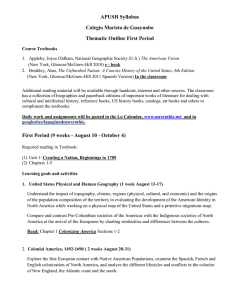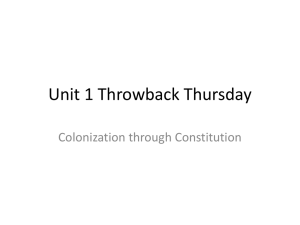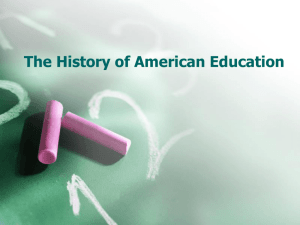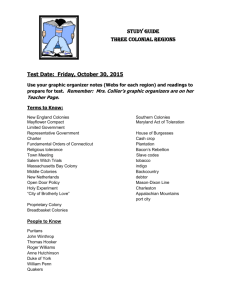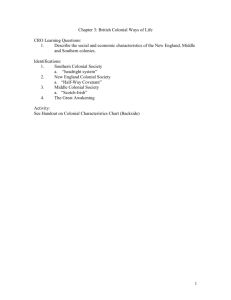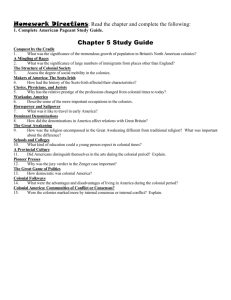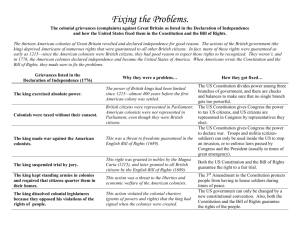Education in the United States
advertisement
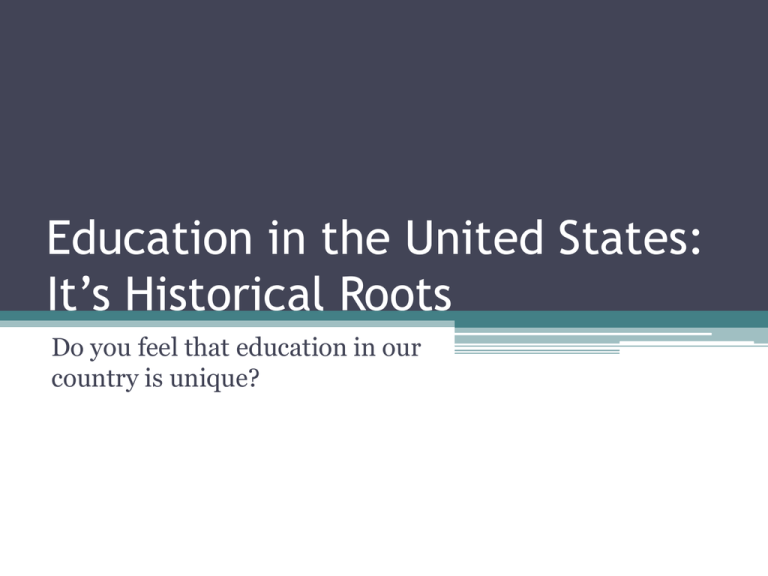
Education in the United States: It’s Historical Roots Do you feel that education in our country is unique? Our Education = Unique • Organize schools • Content we teach • Teaching methods ▫ All differ from those in other countries The Colonial Period (1607-1775) • American education – Jamestown colony ▫ Religion – integral part of colony ▫ Schools were formed to convert people to their religion ▫ Schools – reflected settlers’ values & beliefs ▫ Schools – wealthy white males The Colonial Period (1607-1775) • 3 colonies ▫ Southern Private tutors ▫ Middle Different religious groups form schools ▫ New England Schools – heavily based on religion Most influence on today’s controversy in schools ▫ All schools – memorization & recitation The Colonial Period (1607-1775) • Most classrooms – unpleasant • Teachers – mostly males • Massachusetts Act of 1647 (Old Deluder Satan Act) – designed to produce citizens who understood the Bible. Every town of 50+ to hire a teacher of reading & writing ▫ Birth to the idea that public education could contribute to the greater good of our country. Public support of education The Colonial Period (1607-1775) • European Influence – more humane, childcentered & practical views • Legacy ▫ Source of inequality ▫ Foundation for public support & local control of school (after Act) ▫ Relationship between religion & education The Early National Period (1775-1820) • Answers our questions on the differences of education from state to state. • Before 1775- U.S. looked to Europe for trade & ideas • National Period – colonies became the USA, Constitution & the Bill of Rights The U.S. Constitution • 27 Amendments ▫ 1st 10 – Bill of Rights 1st Amendment – “establishment clause” prohibited government from passing legislation to establish any one official religion over another Separation of Church and state Separation of Church and State • Discussion The U.S. Constitution • 10th Amendment • Areas that are not explicitly assigned to the federal government would be the responsibility of each state. ▫ Removed federal government from a central role in running & operating schools ▫ Gave responsibility to individual states The U.S. Constitution • To support states’ efforts, Congress passed the Land Ordinance of 1785. ▫ At that time, Congress had no power to tax Americans ▫ This raised money by selling land in territories west of the original colonies with income from one section reserved for support of public education ▫ Sometimes the lines are blurry between state & federal The Common School Movement: The Rise of State Support for Public Education (1820-1865) • Still largely reserved for the wealthy • Public Schools ▫ Federal, state & local taxes Salaries Buses Schools Student lunches ▫ Grade level ▫ Content ▫ Licensed The Common School Movement: The Rise of State Support for Public Education (1820-1865) • Making Education Available to All ▫ Private & “quasi” public education Public – often charged partial tuition • States – didn’t coordinate their efforts – education = uneven • Common School Movement – historic attempt to make edu. Available to all The Common School Movement: The Rise of State Support for Public Education (1820-1865) • Important Events ▫ States & local government directly taxed citizens ▫ States created state education departments & appointed state superintendents of instruction ▫ Educators organized schools by grade level & standardized the curriculum ▫ States improved teacher preparation Expansion of the Common School Movement • Parents began viewing education as a way of improving their children’s lives • National & local leaders saw education as the vehicle for assimilating immigrants & improving national productivity • Industry & commerce were growing & required an increasing educated populace The Common School Movement: The Rise of State Support for Public Education (1820-1865) • By 1865, 50% of American children were in school • Elementary school = slowly free • Free secondary schools did not happen until later The Common School Movement: The Rise of State Support for Public Education (1820-1865) • • • • • Teachers – obstacles & challenges Workload – heavy Content – fundamentals – reading & math Poor working conditions (building) Lack of training (most elementary education only) The Common School Movement: The Rise of State Support for Public Education (1820-1865) • Improving Education • Normal Schools – schools to prepare elementary school teachers (2 yr) ▫ 1st attempt to improve ▫ Targeted – women ▫ Content background & training beyond high school The Common School Movement: The Rise of State Support for Public Education (1820-1865) • Elementary School ▫ Grade levels Evolution of the American High School • Comprehensive High School – secondary high school that attempts to meet the needs of all students (different curricular options, interest, ability level) • Before the turn of the 20th century – fewer than 10% = higher school education • Currently, 96% of teens attend high school Evolution of the American High School • Benjamin Franklin ▫ Academy – secondary school focused on the practical needs of colonial America Shifted emphasis to practical curriculum (practical) Removed religion from curriculum (secular) Partially supported by public funds (public) • English Classical Schools – free secondary schools (boys not going to college) Evolution of the American High School • Junior high school – popular until 1970s • Middle schools ▫ Stronger teacher-student relationships = teams ▫ Share information Teaching & Technology • • • • • Projectors & filmstrips Overhead projectors Programmed & computer based instruction Educational television Hand-held calculators The war on poverty & the great society • War on poverty – federal programs designed to eradiate poverty during the 60s ▫ Education – increased federal funding ▫ Support for learners with exceptionalities ▫ The development of the jobs corps The war on poverty & the great society • Head Start ▫ Designed to help 3-5 year old disadvantage children enter school ready to learn ▫ 1965 ▫ Stimulate (encourage) academic achievement & development of low-income ▫ Educate & involve parents in the education of their children Equality • Civil Rights Act of 1964 ▫ Prohibited discrimination against students (color, race or national origin) in all institutions receiving federal funds • Title IX – gender equality • Magnet schools – public schools that provide innovative or specialized programs and accept enrollment from students in all parts of a district ▫ developed to integrate white & minority students


